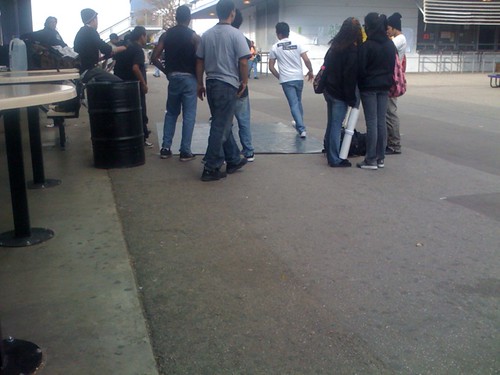
Yes, that’s a group of kids learning to break dance at my school. I was thrilled to see it. As I walked away, I walked behind two girls talking:
– What’s that? Is that called, like, break dancing?
– Yeah, I think so.
– That’s weird.
It basically being finals week for me, things have been a bit hectic on the doctoral side of things (hence the rather long gap between updates in these here parts of the woods). However, I’ve been thinking lately about the implications of space and understandings of it. This relates in numerous ways to research I’m doing in my classes: space and meaning in disciplinary interactions between students and adults, the way graffiti “codes” space within the Manual Arts community, the way new media opens up and occludes space based on access, etc.
I’ve also been trying to think about the way one’s personal space needs to be made more explicit – labeled even, though that sounds wrong and not at all the way I think of borders as splitting us into different people or different kinds of people. (These are thoughts that demand run ons.) I think one of my biggest flaws over the past two quarters has been about being too amorphous. I don’t think I’ve done quite enough reflecting to really make sense of this here other than to say I’m working toward reprioritizing the way I deal with the different hats I wear. Even within the school setting, the teacher hat, mentor hat, advisor hat, and all-that-stuff-that-takes-place-outside-of-my-class-that-gets-mistakenly-labeled-as-“important” hat are occasionally being donned in the wrong order and for the wrong duration. I don’t want to say like I feel like I let my kids down this quarter, but – like most of us – I certainly think I could have given them more. And of course that’s what they deserve and that’s what they should be demanding. Within other spheres I think I’ve been complicating things by continuing to wear – say – the “doctoral student” hat way too often when maybe the hat I should be wearing is something like the wash-the-dishes-and-make-sure-Sadie-isn’t-destroying-the-house hat. Perhaps this sounds more mundane than what I mean but (and again with the run on) space is being construed and interpreted too fluidly and I’m not coming up for air frequently enough to realize that swimming goggles are out of place in a jacket and tie affair.
Arthur has been consistently great with it’s online content. A couple of links I’m throwing here come directly from them, so please support your local/global counterculture zine as much as possible – one of the few publications I feel strongly bout schlepping for. In any case, this article on the NYU occupation felt thrilling. It – also about space – makes me cognizant about the challenges with actualizing the kinds of libratory changes many of us are trying to instill in our students. I’m not worried about how they will be viewed or judged by the mass media, but the article makes it clear what script-flipping will need to look like. Similarly, our Third Space Collaborative met for the second time yesterday. I plan to jot something about that when I find another free moment. Suffice for now, I’ll throw out a thought: is this considered an eco-third space? I think of the tenuous balance between living on and off grid simultaneously and the way such a space could function academically (and no, charters are NOT doing this).
Finally and hot off the presses… er… hot from the oven? I’m excited about the playtest that Greg just wrote about. I think Greg’s game fits in well with this post’s weakly culled theme of space and interpretations of it. I’d be inspired to jump into participating in round 2 of this baking madness if only my biscuit making skills were up to snuff (Daye: kick the recipe over here!). Perhaps my Koreatown neighbors could settle for muffins?







